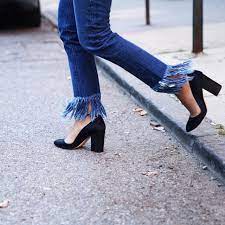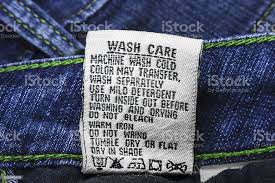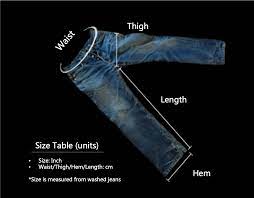Denim jeans are notorious for unraveling. This is most common towards the bottom of the legs, but it can happen elsewhere on the jeans.
When denim begins to fray, it usually gets worse over time. Fortunately, there are a few things you can do to keep your denim jeans from fraying.
In my blog today, we’ll go over the best advisable ways on how to stop Jeans from fraying.

1. Go for genuine jeans materials.
First and foremost, be sure that your jeans are constructed entirely of denim. To imitate the look and feel of denim, some manufacturers employ synthetic materials such as polyester.
The usage of these alternative textiles, on the other hand, can raise the chance of unraveling at the bottom. Furthermore, not all materials are as durable as denim, which might lead to damage when washed and dried.
To avoid this, make sure your jeans are constructed entirely of denim and not of any other materials or fabrics.
2. Don’t drag your Jeans on the ground.

Keep your denim jeans from dragging on the ground. This is maybe the most crucial tip for preventing frayed and unraveling.
During the summer, some men and women wear jeans with sandals or flip-flops, which is a basic yet elegant combo. There’s nothing wrong with wearing jeans and sandals or flip-flops, but the bottoms of your jeans should be considered.
3. Examine the Instructions for Use

It’s a good idea to read the care label on your denim jeans, as it is with other items, for precise advice on how to clean and care for them.
The care label, which is usually found inside the waistband, indicates the safest and most effective ways to care for the jeans. Because different materials and construction processes are used to make different jeans, you should always check and observe the care label.
Don’t wash them in hot water if the label advises “machine wash cold.” The denim fabric may be weakened or otherwise damaged by hot water, increasing the danger of unraveling and fraying.
4. Prioritize quality over quantity.
The quality of your denim jeans will have a significant impact on whether or not they unravel. Jeans of higher grade are less likely to unravel than those of lesser quality.
So, if you’re concerned about something like this happening to your demin, learn to go for quality materials
5. Repair any areas that have been damaged.

If your denim jeans start to unravel or show signs of damage, don’t freak out. You might be able to patch the damage depending on where it is.
Denim patches are available at most craft stores for this purpose. Alternatively, if the damage is only on the bottom of your jeans, you may be able to hem and cut them.
The main conclusion is that unraveled jeans may usually be repaired, especially if the damage is modest. If you’re not confident in your ability to do this repair, take your jeans to a local tailor for assistance. After all, common repairs like this are usually less expensive than purchasing a new pair of jeans.
How to make ripped jeans with a razor
6. Obtain the Correct Fit.

Don’t overlook the significance of selecting the correct size of jeans. Fraying may occur if they are overly large, as the excess cloth is scraped or pulled.
It’s not uncommon for jeans to unravel at the bottom when they drag on the ground, as previously indicated. Normally, this happens only when the jeans are too big to begin with.
If you get the appropriate size jeans, they shouldn’t drag on the ground, unravel, or suffer any other kind of harm. As a result, ensure your jeans are the right size for you.
7. Pulling Loose Threads is a bad idea.
If you find a loose thread in your pants, resist the urge to pull it. Some individuals believe that pulling loose threads out of their pants will prevent them from unraveling further.
However, by doing so, they exacerbate the problem by losing a portion of the jeans’ structural integrity. The jeans will continue to unravel without the thread.
What Should You Do If Your Jeans Have A Loose Thread?
Instead of pulling it out, simply cut it with a sharp blade or a pair of scissors. You also may either stitch it back into the jeans or leave it alone for greater stability.
How Do You Wash Your Frayed Jeans?
To keep your frays from being worse, hand wash your jeans. Fill a big tub halfway with cold water and a pea-sized drop of laundry detergent. To remove any dirt or grease from your jeans, soak them in soapy water for 15 minutes.
Fill your washbasin with clean water and soak your jeans several times to rinse them. After that, lay them out on a level surface or hang them to dry on a clothesline.
Hand washing your ripped jeans is the safest option to clean them because you won’t disrupt the fraying edges.
Tip.
Always turn your jeans inside out before dumping them into the washing machine, whether they’re new or old, damaged or frayed.
This helps to keep the color from changing and reduce damage to the hemlines, pockets, and waistband edges.
Before throwing your jeans in the washing machine, make sure you close zippers and lock buttons to maintain them in shape.
A decent pair of jeans should last you a long time and provide you with a lot of delight. Cheap jeans, on the other hand, are notable for unraveling and fraying after only a few months of wear.

If you’ve had this problem before, go through the above great advices on how to stop jeans from fraying.
It’s important that you use the techniques listed above to safeguard your jeans against this occurrence. Consider purchasing high-quality denim jeans, it’s a wise investment that pays off handsomely in the long run.

